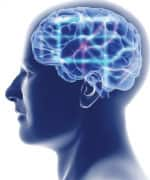Life Extension Magazine®
Dr. Terry Burns could have chosen to pursue any number of professional fields.

With a music scholarship to college, as an undergraduate he traveled with the New England Symphonic Ensemble from Europe to Jamaica and played his French horn in prestigious venues like Carnegie Hall in New York City.
His passion for travel and photography has taken him all over the world, capturing magazine-quality photographs in places like Africa and Australia.
But ultimately, it was his fascination with the brain that led him to pursue a career as a neurosurgeon and scientist.
Burns, an MD, PhD at the prestigious Mayo Clinic in Rochester, Minnesota, splits his time between the operating room, where he removes brain tumors, and the laboratory, where he has one primary goal in mind:
To fix the brain.
A Personal Calling

Like so many people who are passionate about their calling, Burns’ interest in the brain is personal. His grandmother died from Alzheimer’s disease. She was just one of many people in his family who suffered from neurological issues.
As Senior Associate Consultant in the Department of Neurologic Surgery, Burns is in a unique position to have an impact on the lives of not only his individual patients, but also of anyone suffering from a neurodegenerative disease like Alzheimer’s or Parkinson’s.
That’s because Burns is one of the leading figures in the field of neuroregeneration.
“When I was trying to figure out which residency path to pursue after medical school, one of my advisors advised against becoming a neurosurgeon, due to the notorious demands of a neurosurgeon’s schedule. ‘What kind of research do you think you’re going to be able to do as a neurosurgeon without any time?’ she asked.”
“The answer,” said Burns, “is the research that really matters. Research on the human brain.”
And that’s exactly what he’s doing.
In addition to his work as a brain surgeon, Burns is working on developing regenerative strategies to optimize neurological function in patients with brain tumors as well as those with neurodegenerative diseases.
To date, most regenerative therapies have been studied in mice, but Burns believes true success will only come from studying the human brain itself.
“Why do we have all of these cures for mice, but we don’t have anything that works for patients?” asked Burns. “Our brains are different than those of mice. If I’m going to fix the brain, I need access to the brain. We need to be putting the drugs in the brain and see what happens. I came up with this strategy of in vivo drug testing, which is the long-term focus of my lab. We need to put the drugs in the human brain and figure out what the biomarkers are that predict whether or not the drug is working or not working and understand why.”
Scheduled Brain Trauma
As a tumor neurosurgeon, Burns sees firsthand the damaging effects of radiating the brain to treat brain tumors. Radiation is necessary and extends life, but it comes at a price: It causes significant problems with memory, concentration, attention, and more.
“The effects of radiation are very much like accelerated aging. The DNA is damaged by the radiation,” said Burns. “I’ve started calling radiation an iatrogenic (caused by therapy) neurodegenerative state.”
This presents a unique opportunity for Burns to test neuro regenerative therapies.
Currently, in mouse studies, the most effective treatments for neurodegenerative diseases are given prior to the trauma.
“We don’t have that opportunity with conditions like stroke or traumatic brain injury,” said Burns. “But radiation is essentially scheduled brain trauma. It gives us unique access to these patients to study the human brain of individual patients before, during, and after the injury. Not only will this help improve outcomes of patients with brain tumors, but we believe these insights can help us figure out how to treat patients with other neurological diseases.”
The Future of Regenerative Medicine
One main area of focus for Burns and his research team is in a relatively new field called senolytics, which are compounds that remove harmful senescent cells.
Senescent cells have become damaged, but instead of dying off, they stick around and become toxic to the cells around them.
“After patients have had brain radiation, their brain has a lot of these senescent cells, which we believe is a primary issue underlying the side effect of cognitive dysfunction,” said Burns. “These negative effects appear to be improved with senolytic drugs.”
But senescent cells are present in both the radiated brain and in neurodegenerative conditions like stroke and Alzheimer’s. So, studying the use of senolytics in the context of radiation, or “scheduled brain trauma,” may have broader applications for a variety of neurological diseases.
Burns is currently working with a multidisciplinary team to determine if selectively removing senescent cells will combat damage to the central nervous system in conditions like aging, Alzheimer’s, and exposure to brain radiation.
Recent results suggest that certain key mechanisms involved in cognitive performance—like the creation of new brain cells—are enhanced by the effects of senolytic drugs.
An Exciting Work in Progress
One particularly promising senolytic treatment Burns mentioned is the combination of dasatinib and quercetin. Dasatinib is an anti-cancer drug, and quercetin is simply a flavonoid found in natural substances like apples and onions.
Animal studies have shown that this combination selectively removes senescent cells, and as a result, both lifespan and healthspan are improved.
Additionally, Burns explained that a polyphenol called fisetin, which is simply a compound found in foods like strawberries, seems to offer specific protection for the brain. There have been positive results in preclinical trials, and now the first clinical trials are about to get started testing fisetin for the treatment of Alzheimer’s or mild cognitive impairment.
But the promise of senolytics extends far beyond preventing radiation damage—or even improving other neurological diseases.
Indeed, preclinical studies have shown that removing senescent cells with senolytics successfully treated conditions including frailty, cardiac dysfunction, vascular calcification, diabetes, osteoporosis, pulmonary fibrosis, radiation-induced damage, and more.
“It’s an exciting work in progress,” said Burns.
Paradigm Shift
In general, Burns believes the best success for treating neurological diseases will come from utilizing a combination of technologies.
“These diseases are complicated. The likelihood that any one drug by itself is ever going to work is very low,” he said. “We need a dose of humility, and we need to work together.”
Burns explained that the problem with drugs is that pharmaceutical companies tend to want a drug that only works on one pathway.
“Instead, we need drugs that do multiple things,” Burns said. “Those are probably more likely to result from nutraceuticals, Chinese herbs, and other remedies that haven’t yet been rigorously studied. The problem is that since nutraceuticals can’t be patented, they’re not being studied. It’s a process that’s slowing us down.”
Burns believes that increasingly available technologies will allow doctors to learn mechanistically, in real time, how the individual patient’s brain responds to whatever therapy is tried. This would allow them to continue to fine tune, layering on the components of the therapeutic cocktail as needed to restore function and optimize resiliency against disease.
Fortunately, Burns says that the process with pharmaceutical companies is starting to become more interactive and collaborative.
“Until now it’s been all about the drug—recruit patients to test the drug and decide if the drug is a success or a failure. We need to turn that upside down. I don’t care about the drug—this is all about the patient. We must use whatever combination of technologies and therapies is needed to achieve the best outcome for that patient,” said Burns.
Making Alzheimer’s a Distant Memory

In the end, the goal is to find a treatment that won’t just help patients live longer, but to live better.
“Dr. Jim Kirkland ... once said in a talk, ‘No one wants to live to age 130 and feel like they’re 130. We want to add life to years, not just years to life.’ I think that really sums it up,” Burns said. “So, the discussion is much more about improving healthspan, not just lifespan.”
And while there are many roadblocks in this complicated field, Burns is optimistic about the future.
“We have challenges to overcome, but I think we are really seeing the needed tools and understanding come into focus,” he said. “All of this is totally doable. Within our lifetime, I’m optimistic we’ll be able to make diseases like Alzheimer’s a distant memory.” •
Terence (Terry) Burns, MD, PhD, is a neuroscientist in Rochester, Minnesota. In addition to his work as a brain surgeon, he is developing regenerative strategies to optimize neurological function and quality of life for patients with brain tumors, neurological injuries, and neurodegenerative diseases.
If you have any questions on the scientific content of this article, please call a Life Extension® Wellness Specialist at 1-866-864-3027.

